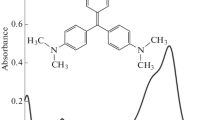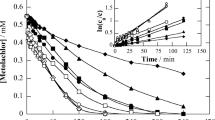Abstract
This paper describes the development of electrochemical processes for the oxidative degradation of toxic organic chemicals in waste waters. Doped bismuth lead dioxide anodes have been tested by the kinetic study of phenol anodic oxidation in aqueous solution. The main products during oxidative degradation of phenol are 1,4- benzoquinone, maleic acid and carbon dioxide. Several deposits of Bi2O5–PbO2 on Ti/(IrO2–Ta2O5) substrates have been prepared by anodic oxidation of Pb2+ and Bi3+ in aqueous solutions containing perchloric acid to increase the solubility of bismuth. To study the effect of perchlorate ions, the efficiency of the PbO2 deposit prepared from lead nitrate in an aqueous solution (pure PbO2) was compared with that of a deposit prepared from perchloric acid solution (perchlorate doped PbO2). Although the phenol is oxidized at the same rate on the two deposits, the charge corresponding to the total elimination of 1,4-benzoquinone is three times higher for perchlorate doped PbO2 than for pure PbO2. Phenol degradation is more efficiently carried out on a PbO2 anode doped with perchlorate and with bismuth than on the same electrode doped only with perchlorate. Among the electrodes tested in this work, the pure PbO2 anode is the most efficient for phenol degradation. It is assumed that certain active sites on the anode occupied by perchlorate ions do not participate in the transfer of oxygen atoms and that for the PbO2 electrode doped with bismuth, oxygen evolution is favoured to the detriment of oxygen atom transfer.
Similar content being viewed by others
References
J. E. Vitt and D. C. Johnson, J. Electrochem. Soc. 139 (1992) 774.
Ch. Comninellis and C. Pulgarin, J. Appl. Electrochem. 23 (1993) 108.
N. Belhadj Tahar, Thesis, Université Paul Sabatier, Tou-louse (1996).
N. Belhadj Tahar and A. Savall, in 'Fundamentals and Potential Applications of Electrochemical Synthesis', edited by R. D. Weaver, F. Fisher, F. R. Kalhammer and D. Mazur, (The Electrochemical Society, Penning-ton, NJ, 1997), pp. 198–206.
N. Belhadj Tahar and A. Savall, submitted to J. Electro-chem. Soc. 145 (1998) 3427.
H. Sharifian and D. W. Kirk, J. Electrochem. Soc. 133 (1986) 921.
M. Gattrell and D. W. Kirk, Can. J. Chem. Eng. 68 (1990) 997.
Ch. Comninellis and C. Pulgarin, J. Appl. Electrochem. 121 (1991) 703.
M. Gattrell and D. W. Kirk, J. Electrochem. Soc. 140 (1993) 1534.
E. Brillas, R. M. Bastida and E. Liosa, ibid. 142 (1995) 1733.
A. Savall and N. Belhadj Tahar, in 'Environmental Technologies and Trends', Proceed. Earthcare, edited by R. K. Jain, Y. Aurelle, C. Cabassud, M. Roustan and S. P. Shelton, (Springer-Verlag, Berlin, 1996), pp. 262–269.
N. Belhadj Tahar and A. Savall, J. New Mater. Electro-chem. Syst. (in press).
B. Fleszar and J. Ploszynska, Electrochim. Acta. 30 (1985) 31.
H. Chang and D. C. Johnson, J. Electrochem. Soc. 136 (1989) 17.
I. H. Yeo, S. Kim, R. Jacobson and D. C. Johnson, ibid. 136 (1989) 1395.
Ch. Comninellis, Electrochim. Acta 39 (1994) 1857.
J. Feng, L. L. Hook and D. C. Johnson, J. Electrochem. Soc. 142 (1995) 3626.
I. H. Yeo and D. C. Johnson, ibid. 134 (1987) 1973.
W. R. Lacourse, Y. L. Hsiao and D. C. Johnson, ibid. 136 (1989) 3714.
J. C. Grigger, H. C. Miller and F. D. Loomis, ibid. 105 (1958) 100.
K. C. Narasimham and H. V. K. Udupa, ibid. 123 (1976) 1294.
N. Munichandraiah, and S. Sathyanarayama, J. Appl. Electrochem. 17 (1987) 22.
N. Munichandraiah, ibid. 22 (1992) 825.
J. Rolewicz, Ch. Comninellis, E. Plattner and J. Hinden, Electrochim. Acta. 33 (1988) 573.
L. Papouchado, R. W. Sandford, G. Petrie and R. N. Ad-ams, J. Electroanal. Chem. 65 (1975) 275.
M. Fleischmann, I. R. Hill, G. Mengoli and M. M. Musiani, Electrochim. Acta. 28 (1983) 1545.
B. S. Nielsen, J. L. Davis and P. A. Thiel, J. Electrochem. Soc. 137 (1990) 1017.
C. N. Ho and B. J. Hwang, Electrochim. Acta. 38 (1993) 2749.
Author information
Authors and Affiliations
Rights and permissions
About this article
Cite this article
Belhadj Tahar, N., Savall, A. Electrochemical degradation of phenol in aqueous solution on bismuth doped lead dioxide: a comparison of the activities of various electrode formulations. Journal of Applied Electrochemistry 29, 277–283 (1999). https://doi.org/10.1023/A:1003433519200
Issue Date:
DOI: https://doi.org/10.1023/A:1003433519200




